Is it really true that skipping routine motorcycle safety checks can lead to serious accidents? You might think your bike is in perfect condition, but unnoticed issues can escalate quickly. Performing these checks not only guarantees your motorcycle operates smoothly but also protects you as a rider. Consider how simple actions like inspecting your tires or brakes can make a significant difference in your safety and overall riding experience. What could you discover about your bike's condition before hitting the road?
Key Takeaways
- Regular safety checks ensure optimal motorcycle performance, enhancing both rider safety and overall riding experience.
- Proper tire condition and pressure prevent accidents due to poor grip and overheating.
- A well-maintained brake system is crucial for effective stopping power and emergency response.
- Monitoring fluid levels prevents overheating and mechanical failures, ensuring smooth operation.
Importance of Regular Safety Checks
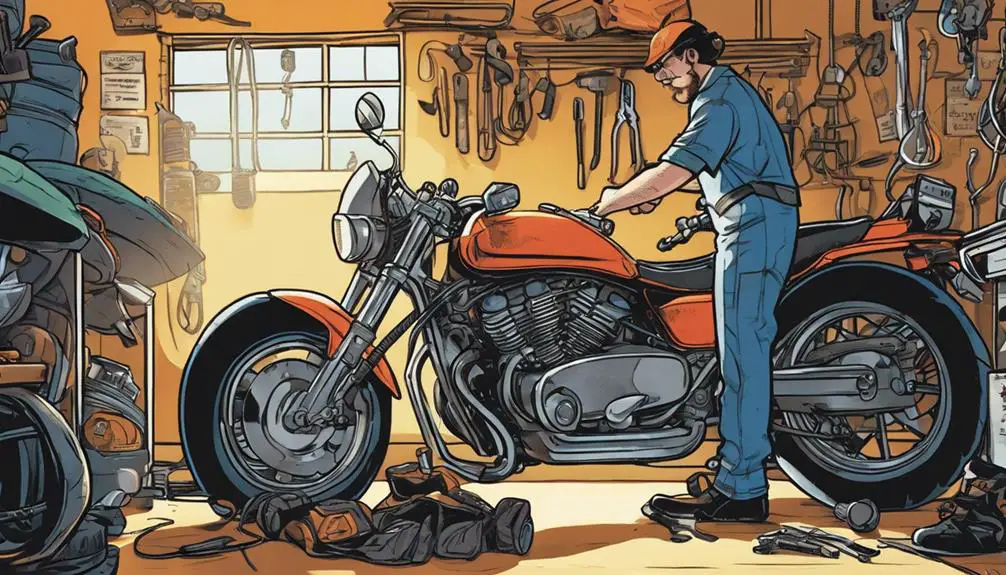
Regular safety checks are essential for ensuring your motorcycle's performance and your safety on the road.
When you take the time to inspect your bike regularly, you're not just protecting your investment; you're embracing the freedom that comes with riding responsibly. After all, nothing beats the thrill of the open road, but it's crucial to know your machine is in top shape.
Start by checking your tires—look for wear, proper inflation, and any signs of damage.
Next, inspect your brakes; they're your lifeline in emergencies.
Don't forget to review your lights and signals; visibility is key to staying safe.
Your oil levels and chain tension matter too, so give them a quick check-up.
Essential Ducati Safety Components
Ducati motorcycles come equipped with essential safety components that enhance your riding experience and keep you secure on the road. One of the standout features is the advanced braking system, which includes ABS technology. This system prevents your wheels from locking up during sudden stops, giving you more control in critical situations.
Another key component is the traction control system. It helps you maintain grip on slippery surfaces, allowing you to release the bike's power without fear. This feature empowers you to ride confidently, no matter the conditions.
The sturdy frame and suspension setup on Ducati bikes also play an important role in your safety. A well-designed frame provides stability, while an adjustable suspension guarantees you can tackle different terrains without compromising your ride quality.
Don't overlook the visibility aspects, either. High-intensity LED lights not only brighten your path but also make you more visible to other road users.
With these safety components, you're not just riding a motorcycle; you're embracing the freedom of the open road while prioritizing your well-being. So, gear up, enjoy the ride, and trust in the safety features that Ducati has to offer.
Tire Condition and Pressure
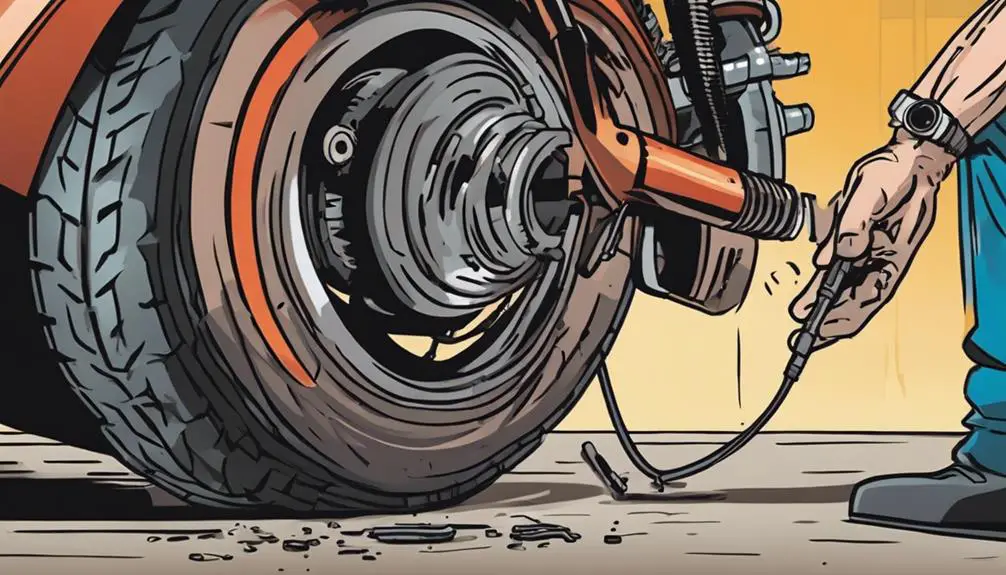
Ensuring your motorcycle tires are in good condition and properly inflated is essential for safe riding and ideal performance. Tires are your only contact with the road, so neglecting them can lead to serious consequences.
Start by checking the tread depth; worn-out tires provide less grip and increase your chances of skidding, especially in wet conditions. Use the penny test: insert a penny into the tread, and if you can see all of Lincoln's head, it's time for new tires.
Next, assess the tire pressure. Under-inflated tires can overheat and wear unevenly, while over-inflated tires can lead to a harsh ride and reduced traction. Use a reliable gauge to check the pressure, and always refer to your motorcycle's manual for the recommended PSI. Adjust accordingly, and don't forget to check both front and rear tires.
Regularly inspecting your tires not only enhances your safety but also boosts your motorcycle's performance. Take this responsibility seriously; it liberates you from the fear of unexpected mishaps on the open road.
Embrace the freedom that comes with knowing your ride is in top shape. Your journey deserves nothing less.
Brake System Inspection
You should always check your motorcycle's brake system to guarantee it's functioning properly before hitting the road.
Your freedom on two wheels depends greatly on reliable brakes, so don't overlook this essential inspection. Here's what you need to focus on:
- Brake Pads: Inspect for wear and tear. Worn-out pads can compromise your stopping power.
- Brake Discs: Look for any signs of damage or warping. Smooth, undamaged discs contribute to effective braking.
- Brake Lines: Check for cracks or leaks. Healthy lines guarantee your brake fluid stays where it should.
Fluid Levels and Leaks
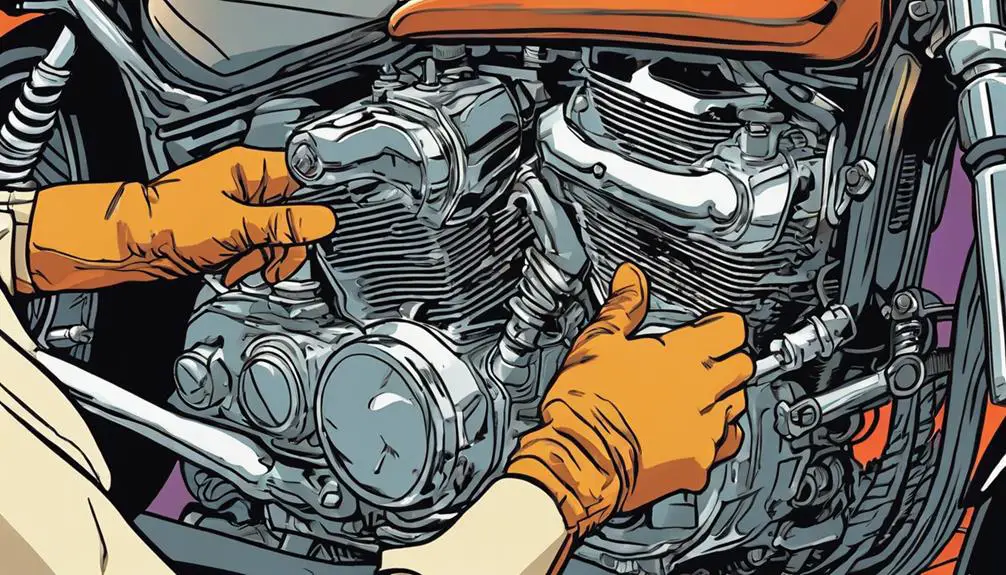
After confirming your brake system is up to par, it's vital to check the fluid levels and look for any leaks that could affect performance.
Fluid levels – whether it's engine oil, coolant, or brake fluid – are important for your bike's functionality and reliability. Low levels can lead to overheating, reduced braking power, or even engine failure.
Start by checking the oil level through the sight glass or dipstick, ensuring it's within the recommended range. If you notice it's low, top it off with the appropriate type.
Next, inspect your coolant reservoir; a low coolant level can lead to overheating, especially on those long rides.
Don't forget to examine the brake fluid level as well, ensuring it's at the right mark. If you spot any leaks around hoses, gaskets, or seals, address them immediately.
Leaks can be a sign of deeper issues and could compromise your safety.
Lights and Indicators Functionality
When you're on the road, having working lights and indicators is essential for your safety.
They enhance your visibility to others and guarantee your signals are clear.
Let's go over how to check that everything is functioning properly.
Importance of Visibility
Ensuring that lights and indicators are functioning properly is essential for maintaining visibility on the road and preventing accidents. When you're out riding, your ability to be seen is just as important as your ability to see. You don't want to be invisible, especially when you're sharing the road with larger vehicles.
Here's what to check to keep your presence felt and safe:
- Headlight: Make sure it illuminates the path ahead and is bright enough for others to notice you.
- Taillight: This warns those behind you of your presence and intentions.
- Brake lights: They signal your slowing or stopping, giving others a heads-up to react.
Indicator Signal Clarity
Clarity in your indicator signals is essential, as it directly impacts how effectively you communicate your intentions to other road users. When you're out on the open road, every twist and turn matters. If your indicators are dim, flickering, or completely out, you're risking miscommunication and potential accidents. Regularly check your turn signals and brake lights to guarantee they're fully operational.
Remember, you're not just riding for yourself; you're sharing the road with others. Clear signals help drivers anticipate your moves, making the ride smoother and safer for everyone. If your indicators are working perfectly, you're embracing a sense of freedom, allowing yourself to navigate the world with confidence.
Take a moment before each ride to assess your lights. Are they bright and visible? Do they flash at the correct speed? If not, it's a quick fix that can save you from more serious issues down the line.
Chain and Sprocket Maintenance
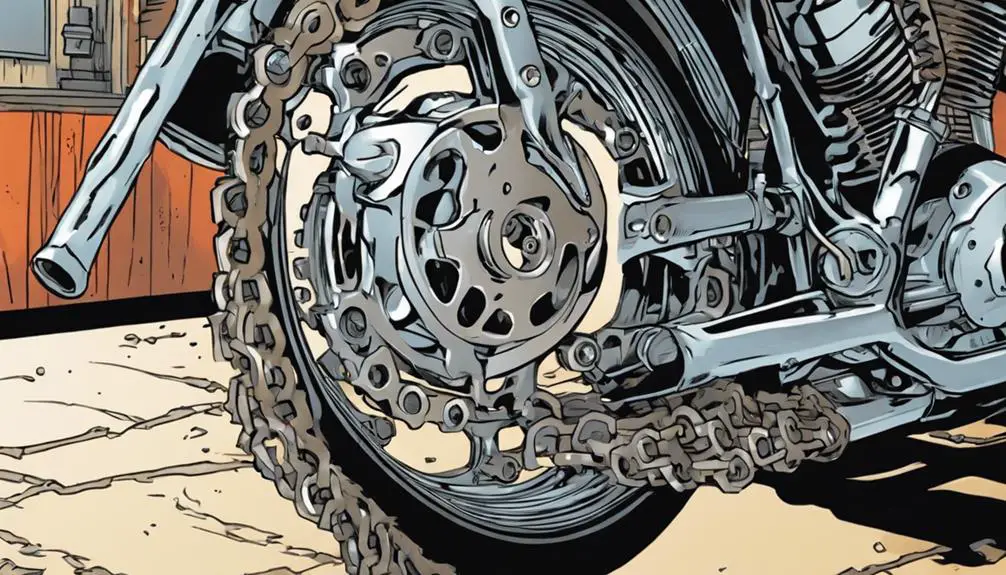
Regularly checking and maintaining your motorcycle's chain and sprockets is essential for peak performance and safety on the road.
A well-tuned chain and sprocket system guarantees smoother rides, better acceleration, and reduces the risk of breakdowns. Plus, it gives you the freedom to explore without worries.
Here are some key points to focus on:
- Inspect for wear: Look for signs of stretching or damage on the chain and sprockets. Any noticeable wear can affect your ride.
- Check tension: Verify your chain has the right tension—too tight or too loose can lead to problems down the road.
- Lubricate regularly: A well-lubricated chain reduces friction and prolongs its life. Don't skip this step!
Battery Health and Connections
Maintaining your motorcycle's battery health and connections is just as important as keeping the chain and sprockets in top shape for reliable performance. A strong battery guarantees that you'll have the power to start your bike and keep all electronics running smoothly.
Start by checking the battery terminals for corrosion or loose connections. A clean, tight connection can prevent unexpected breakdowns on your ride.
Next, examine the battery's condition. Look for any signs of swelling or leaks. If your battery's performance seems sluggish, it might be time for a replacement. Regularly testing the battery voltage is also vital; a healthy battery should read around 12.6 volts or more when fully charged.
Don't forget to inspect the charging system, too. If you notice the battery isn't holding a charge, it could indicate issues with the alternator or regulator.
Keeping your battery and connections in good shape not only enhances your motorcycle's performance but also contributes to your freedom on the road. After all, nothing feels quite as liberating as knowing your ride will start when you need it most.
Overall Bike Cleanliness and Care
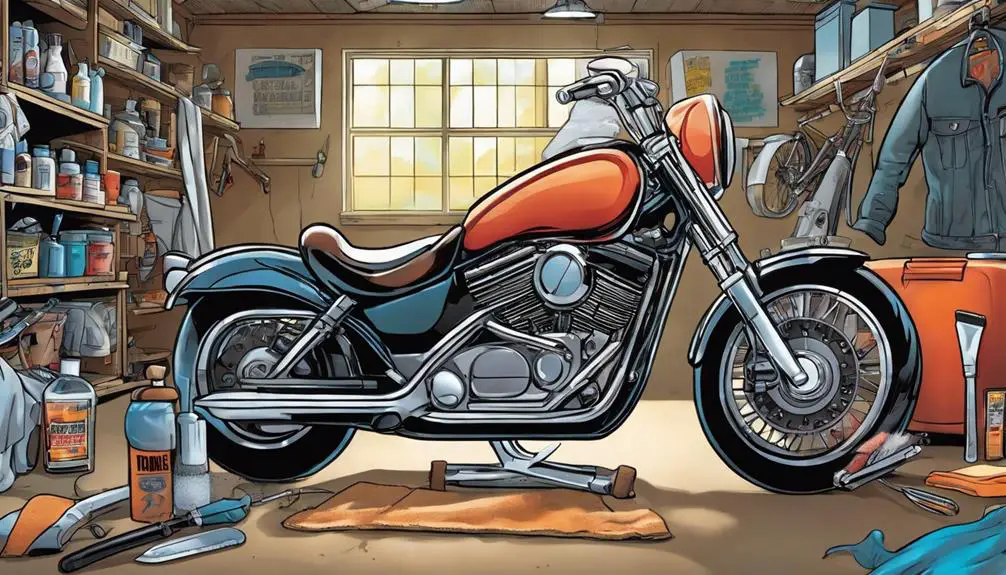
Keeping your motorcycle clean not only enhances its appearance but also protects its components from rust and wear. A well-maintained bike isn't just a joy to ride; it guarantees your safety on the road. Neglecting cleanliness can lead to mechanical issues and diminish your riding experience.
Here's how to keep your ride in peak condition:
- Wash regularly: Dirt and grime can trap moisture, leading to corrosion. Use mild soap and water to wash your bike after every ride.
- Inspect for damage: Check for scratches or chips that could expose metal to the elements, and address them promptly.
- Wax for protection: Applying wax not only makes your bike shine but also creates a barrier against moisture and road debris.
Frequently Asked Questions
How Often Should I Perform Safety Checks on My Motorcycle?
You should perform safety checks on your motorcycle at least once a month, but don't wait until then if you ride frequently.
Before every ride, give it a quick once-over—check the tires, brakes, and lights. If you notice anything off, address it immediately.
Regular checks not only keep you safe but also enhance your freedom on the road. Embrace the thrill of riding, but don't forget your bike's well-being!
What Tools Do I Need for Basic Safety Checks?
To ride free like the wind, you need the right tools for basic safety checks.
Grab a tire pressure gauge, a multi-tool for adjusting bolts, and a flashlight to inspect those hard-to-see spots.
Don't forget a cleaning cloth for your mirrors and lights!
A torque wrench will help you verify everything's tightened just right.
With these essentials in hand, you're ready to keep your bike in top shape and embrace the open road.
Can I Perform Safety Checks in Bad Weather?
You can absolutely perform safety checks in bad weather, but it's essential to be cautious.
Wet surfaces and limited visibility can make the process trickier.
Make certain you're properly dressed and have good grip on your tools.
Focus on important checks like brakes and lights; these are critical for your safety.
If conditions are too severe, it might be wise to wait until the weather improves to guarantee a thorough inspection.
Are There Any Motorcycle Models That Require Special Safety Checks?
Yes, some motorcycle models require special safety checks, especially high-performance bikes or those with unique features.
If you ride a sportbike, for instance, you should pay extra attention to tire pressure and brake systems.
Additionally, touring bikes may need checks on their electrical systems and luggage setups.
Always consult your owner's manual for specific guidelines, ensuring you're fully prepared to enjoy the freedom of the road without compromise.
What Should I Do if I Find a Problem During a Safety Check?
If you find a problem during your safety check, don't ignore it. Address it immediately.
Depending on the issue, you might need to tighten loose components, replace worn-out parts, or even consult a mechanic for more complex repairs.
Trust your instincts; your safety and freedom depend on a well-maintained ride.
Remember, a proactive approach today guarantees you enjoy the open road tomorrow without worry.
Take charge of your bike's health!
Conclusion
In the grand symphony of riding, every note matters—your safety checks are the conductor.
By tuning up your motorcycle with regular inspections, you're not just preserving its performance; you're crafting a masterpiece of safety and reliability.
So, before you hit the open road, remember: a well-maintained bike is like a trusted companion, ready to carry you through every twist and turn.
Embrace these checks, and let your ride be a harmonious journey, free from the discord of mechanical failures.